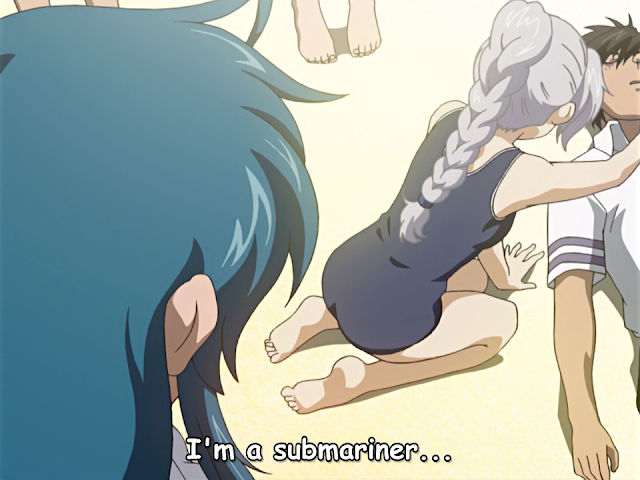If you ask me about shoujo manga I have read, I can easily divide them into two groups: the one I completely dislike, when authors try to keep the readers' attention by not letting them enjoy seeing the heroine happily united with her beloved and constantly creating troubles out of nothing; the other – more simplistic but, thanks to that, much more enjoyable, plain but captivating. Even when mangakas try to add something bittersweet, the ending is usually happy and relieving.
That won't do with shounen genre. Probably there's not a single work I've read that can be judged so simply. And the strangest thing is that you don't know before you start watching or reading - you don't know that what starts as your usual shounen adventure will be one of the most impressive works you have read in your life.
Accompanied by soft melodies sung by Mikuni Shimokawa, the first season was a good way to spend my free time watching something interesting. At first I thought those melodies too soft for such an energetic story, until I finally understood what they are about
A calm, peaceful, happy world which is the ultimate goal of all the fighting.
At some points I liked the pace of the anime more than of the manga, but at another I enjoyed manga more. I guess this is the rare case when both anime and manga are independent interpretations of the original novel, and since both have strong sides, I wouldn't say which is better, though of course manga is more profound since it is longer.
I know there are female mangakas who write shounen manga from a boy’s perspective, moreover, they make it so cruel it’s hard to bear. I also know there are male mangakas who write manga about girls as if they knew exactly what’s going in their heads. However, in case of FMP, the gender roles are just what you’d expect, typical. Retsu Tateo created though a shounen, but with a girl, Kaname, in the centre, showing much of her emotional experiences during the events. Compared to the fast-paced anime, I could more thoroughly enjoy her moments of happiness, especially after I was scared together with her, angry together with her, and sad and lonely together with her. Other characters and other chapters are also depicted from a woman’s point of view, and while it may be not very obvious from the beginning, this feeling grows with time.
After the author changes to Hiroshi Ueda in FMP Sigma, Sagara turns into your typical shounen hero
As for Kaname – she doesn’t turn into a maiden in distress, and that’s a fact I am extremely grateful to the authors for,
but she gets more distant and is shown less, by which I mean that she both appears less, and that within the time she is given her thoughts and feelings are given less time in comparison to the first manga.
However, what I noticed while reading the second manga is that though I got to see less Kaname, I got to see more Sagara and other characters with their feelings, doubts, past traumas and current inner struggle, again given more time than in the anime and thus deeper, finally providing me with understanding of their actions.
All this may seem good, but for one thing: I started to read it as a usual shounen adventure, hoping to see the enemies defeated triumphally and the main characters living happily ever after. Instead, it got darker and darker, too serious with time, making me deal with problems like unwanted cruelty, philosophical issues and time warps causing some favourite characters to change their way and other favourite characters die. By the way, this is not an entertainment show about conquering the world, and I am almost amazed at myself for being able to stay sane with so much blood.
The last several volumes were a trial for me. Constantly worrying about the characters, plunging into despair and climbing the mountains of hope, I spend several days completely out of the real world. In the end I can say that all the 'good fellows' are worthy of respect, and those who strayed from the right path are worthy of pity. Not a single of them, not a single relationship was left without attention, including supporting characters and even the AI. I'll add FMP to my list of works with impressive characters.
The art gets more pleasant and sophisticated around volume 6, when the characters finally look realistic and attractive. Sagara turns into an athletic young man rather than a pathetic youth he was in volume one.
By the last volume, the Ueda's style changed significantly. He said himself he liked this final version most of all, and though I'd never agree this is very beautiful, I'd say it was solid.
Anime art was good enough too, getting even better and better with years.
The last thing to add to this perfection is music by Sahashi Toshihiko and incredible quality of voice acting by the cast.
Still, FMP is not only about blood and struggle. It's also about completely awkward situations,
toy bears speaking with horses,stupid puns,
and bawdy jokes.
I guess the author himself couldn't bear constant gloomy battles and had to insert unexpected situations to laugh at. And that again made the characters even more lovable.
I don't like plain words in anime and manga, and it's been a long time since I was impressed by a scene when a defeated enemy admits he has lost to the power of love, but when love is protected by such people in such circumstances, I have to take my hat down. Despite the huge amount of nerves that I have lost with no change of recovering, I don't regret reading.


















